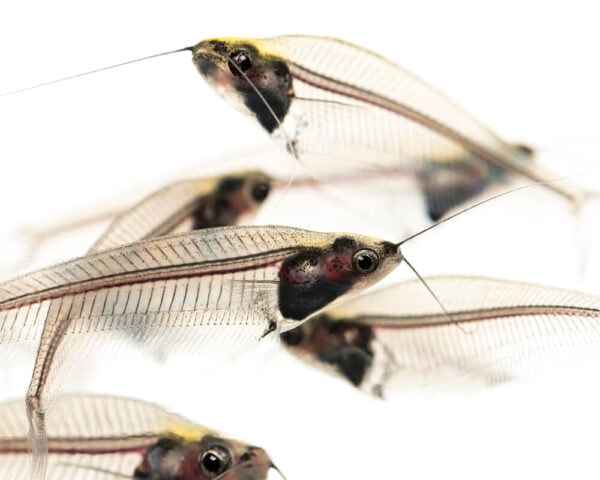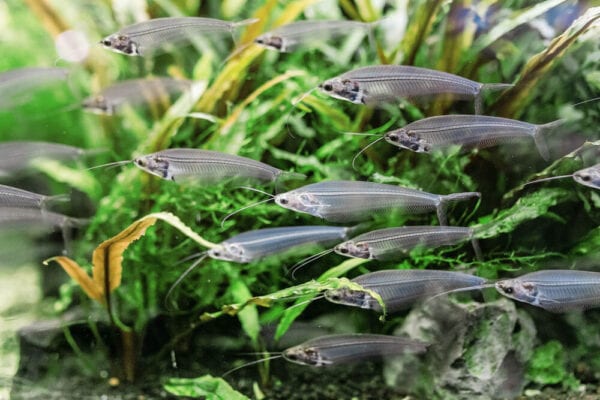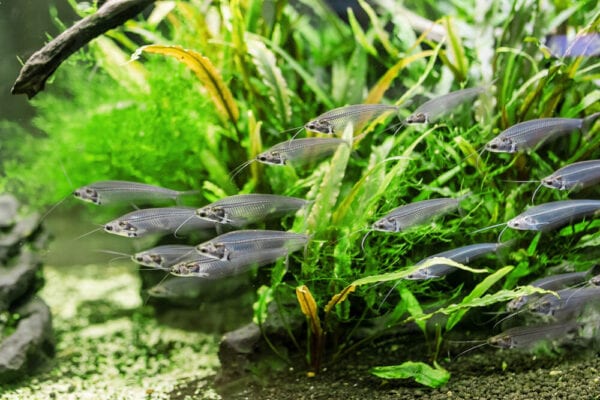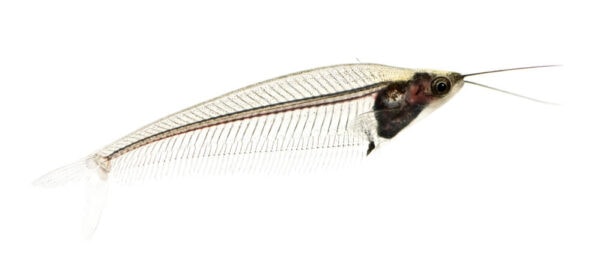Also known by some as the Ghost Catfish, the kryptopterus vitreolus(the fancy scientific name) is a small freshwater glass fish species from Southeast Asia.
Vitreolus comes from the Latin word “vitreus”, meaning glass and the Greek kryptos, meaning hidden (not very cryptic). Coming from the siluridae family, the spines of this catfish family do not extend past their dorsal or adipose fins, and their dorsal fins may be small or lacking altogether.
Table of Contents
Glass Catfish: A Quick Summary
The Glass Catfish is a small, transparent fish native to Southeast Asia. It is known for its delicate, see-through body and peaceful temperament, making it a popular choice for community aquariums. Glass Catfish are typically found in groups in the wild and do well in tanks with other peaceful fish.
Overview
These transparent and unique additions to your tank can play well with other peaceful species. For the hardcore hobbyists, knowing how to care for these one-of-a-kind fish is important.
When the light catches their “skin” just right, you will see the subtle yet impressive iridescent glow of a rainbow. You may also have learned in the past the scientific name of this tame species of fish was kryptopterus bicirrhis, but that has since been agreed upon as a misidentification, and that name is now reserved for larger and less peaceful glass catfish alone.
They are relatively easy to care for and due to their peaceful and tame natures, they are a safe addition to your tank. They might be a little timid at first, but give them a few weeks and you’ll see a much livelier tank. They tend to band together in schools and look quite different to your stereotypical catfish (you know, the ones that suck onto rocks).
Since they lack pigment, they have a tendency to avoid the sun, which makes having plants in your tank a necessity for these little creatures.
- Care Level: Moderate
- Temperament: Calm and generally peaceful
- Color: Transparent!
- Lifespan: Anywhere from 7-8 years with good care
- Size: Around 5 inches
- Diet: Omnivorous. Their diet should consist of flake and freeze-dried foods such as bloodworms etc.
- Family: Siluridae
- Minimum Tank Size: 30 gallons at the very least.
- Temperature: They are sensitive to changes in the water, and 25-degrees Celsius (77-degrees Fahrenheit) is recommended.
- Water Conditions: Slightly acidic, with a pH level of around 6.5. Low water hardness (less than 10 dGH is ideal but definitely below 20).
- Compatibility: Community tanks. They can live in harmony with other peaceful species.
Where are glass catfish from?
The glass catfish is indigenous to Thailand and maybe even in Penang, Malaysia. Not surprisingly, the “glass” part of their trade name stems from their transparent appearance. Much like the glass frog, you can see through their “skin” as they are scaleless and lack body pigments.
Appearance

Most creatures with the word “glass” or “ghost” in their names would indicate transparency to their appearance (hence the glass frog and ghost shrimp). Most of the organs of the glass catfish are located near its head.
If you look closely enough, you may even be able to see their heart beating! Their transparency allows you to have a clear line of sight to their organs and spine.
Their tail fins are barely visible and that slight hump you may notice on their backs are actually their dorsal fins. You may instinctively feel that their transparent exterior makes them more vulnerable and weaker to predators.
However, it’s quite the opposite as their clear bodies have a camouflage effect that makes them hard to see.
Those whisker-like feelers you see protruding from their noses may remind you of land-living cats and are referred to as barbels. These “feelers” are what makes these fish very sensitive to changes in the water. They may even be able to detect electromagnetic waves!
These aren’t big fish, and only max out at about 5 inches. They are naturally slender and while transparent usually means clear and colorless, you can see an iridescent glow if the light hits them right.
Their Behavior
They really do add a little something extra to your tank. From novice fish owners to hobbyists to the seasoned aquarists, the glass catfish are a great addition.
They can be quite energetic and unlike most other catfish species, the glass catfish don’t linger at the bottom of the tank. They like free-swimming and will swim around usually in the middle of your tank.
They are peaceful, get along with other fish and do well in community tanks. They mind their own business and you may find them hiding away between plants and other decorations in your tank to avoid sunlight.
Ideal Glass Catfish Tank Conditions

Glass catfish are freshwater fish that are endemic to Thailand, where they thrive in rivers and streams. To simulate that environment would be the ideal tank conditions.
They rely much on their barbels for visibility and survival. It’s hard to see through the water where these little fish are from, and while they may be near invisible in their home habitats, you will be able to see them (just barely) in your tank.
As mentioned above, it’s best to keep their tank environment steady and consistent. They do not do well with changes so try not to fluctuate the water conditions too much.
Ideal Water Conditions
Below are the ranges of guidelines to follow. It may differ from tank to tank since you may have other fish to accommodate. It’s morbid but we’re going to say it, if you do not follow these guidelines (rules really) strictly, your fish are at risk of dying.
- Temperature: 24-27 degrees Celsius (75-80 degrees Fahrenheit)
- Water Hardness: Lower than 10 dGH and definitely below 20.
- pH Level: 6.5-7
- Water Flow: Moderate
Although they are a species we recommend for beginners, they are more difficult to care for due to their sensitivity compared to other fish. Remember to look for a 30-gallon tank or more, especially if they have lots of tank mates!
They need lots of room since they are free swimmers, you will likely find them residing in the mid to upper levels of your tank. In a 30 gallon tank, you’re looking at keeping around 6 glass catfish. That translates to about 1 per 5 gallons.
However, they do not stray too far from their larger cousins who like to dwell on the sea bottom sucking on rocks. They still favor dark places and you may constantly find them hiding among the plants and rocks in your tank.
Since they like to play hide-and-seek, it’s imperative to keep their home full of aquatic growth. This will keep the water cleaner too! Look into plants such as the Java Fern and Moss and other such plants.
As for the makeshift seabed, use thinner and smaller-grained sand and gravel as to not damage their barbels.
Glass Catfish Maintenance and Care
If you manage your tank conditions with stringent standards, then they will most likely be okay. The biggest hurdle to keeping the glass catfish and making sure they hit the 7-8 year mark is the changes in water conditions. It can be tough for some to maintain these strict standards.
They are pretty resilient in terms of diseases and are not affected by much. They are susceptible to issues that plague most aquarium fish such as:
- Ich: Growing white moldy-looking sand-like substance on their skin, accompanied by gasping for air at the top of your tank.
- Dropsy: Bloating and scales protruding. This can be harder to tell on these skeleton fish since they are clear and scaleless.
- Fungus: I think we are quite clear what fungus is/looks like. It’s usually grey or white substance on the fins.
- Lice: Much like how lice would bother us, you’ll see your little fish rubbing themselves on rough surfaces such as the tank bed or rocks to remove the lice.
It’s easy to avoid the above sicknesses by keeping the water parameters consistent, change the water regularly and keep up with a regular diet, your fish will be healthy and happy.
To make sure you aren’t exposing the rest of your tank to any issues when you add new members, quarantine them in a smaller tank to make sure they aren’t sick before introducing them.
Filtration
Using the best and/or right filtration system is vital to taking good care of your fish. It’s fun to design and set up your aquarium and find all the rare plants and rocks, but the filtration system should be your main concern. In this case, bigger is better.
Some filters are fixed, but others can handle different tank sizes. Make sure you purchase one that’s recommended for 30 gallons or more (since that’s the smallest you should get for glass catfish.
The water flow rate should be higher, and cycle the water in the tank.
Diet
Diet was mentioned in our care guide because food and sustenance is key to health for any living creature. In order to provide your little glass aquatic pets with the best care, you must familiarize yourself with their diet.
What do glass catfish eat?
In the wild, their diet usually consists of zooplankton, small works and invertebrates. They can be quite picky in the tank and have also been said to prefer live food such as mosquitos and even brine shrimp.
How do you simulate this diet in a tank? Freeze-dried food as mentioned above and other live sources of food such as Grindal Worms, Moina and brine shrimp will do.
It’s easy to overfeed fish and that can lead to many dangerous health issues that could infect the entire tank.
Here are a few tips to help alleviate the problem of overfeeding:
- Feed your fish on a schedule (about twice daily).
- Feed only what is needed (generally, only feed them however much they can eat in under 5 min)
- Make sure all the fish are eating, none are being bullied out of their meals. It could also indicate sickness if a fish isn’t interested in its food.
- It may be hard to remember not to feed according to tank size. You may naturally want to fill it with more food but this is wrong. Simply spread the food among the tank so all the fish can eat at the same time.
- Just like any other pet, making sure your fish get the best quality food is the job of a responsible pet parent. Choose the right form of food (pellets or flakes) which you choose depends on the species of fish.
- Something that is extremely important that not a lot of novice fishkeepers know or do is to remove the leftovers. Clean up all the leftover food (or as much as you can) using a net.
- To help with the above-mentioned issue of uneaten food, you can add scavenger fish or other inhabitants to your tank. They help clean up the uneaten food and can get into places that may be harder for you to clean.
- Introduce new food slowly, give your fish some time to get used to the new diet.
Suitable Tank Mates for a Glass Catfish

You may already have existing fish in the tank or are thinking about adding a few friends for your glass catfish. Before you can do that, you need to know who they can live peacefully with.
These friends, or otherwise known as tank mates (how cute) should also have a mild temperament. You can even build your way up to a community tank, which is a tank filled with many species of fish that can live in harmony.
Fish that can coexist well with the glass catfish are Celestial Pearl Danios, Discus, Neon Tetras, Zebra Danios, Whisker Shrimp and even guppies!
Are Glass Catfish Aggressive?
No, quite the opposite. Glass catfish are timid and therefore are more comfortable in groups of 4 or more fish, especially if there are other aggressive fish in the tank.
However, steer clear of larger and more aggressive fish. They may bully and even attack and eat the more calm and restful species.
Freshwater fish that are not aggressive, are pretty easy to keep, and thrive in a similar environment as the glass catfish with a love of similar food can make great tank mates.
Can glass catfish live alone in the tank?
Due to their very timid nature, it’s better to keep these fish in groups of 4-6, especially if you have other fish in your tank.
Glass Catfish Breeding
In their native Thailand, these fish breed in the monsoon season. How they breed in a tank setting, however, remains a mystery. Although there have been a few reports of people breeding them successfully in captivity, the rate is not high at all.
You need to make sure you have at least 1 of each sex. It’s very difficult to tell between male and female glass catfish with the females only being slightly larger and having a very subtly larger belly for eggs.
The best way to try and simulate a suitable environment for breeding in the tank is to lower the temperature by a bit to around 23 degrees Celsius (73 degrees Fahrenheit), then add some fresh water every day (not too much).
This makes it feel like rainwater is being added. This is also what might get the fish to believe it’s the raining season and time to start breeding.
Doing everything you can to make sure they feel right at home (their native home) is how you can get the fish to make babies. This also includes making sure there is an abundance of live food at this time. The live food will provide your glass catfish with the energy to mate.
Make sure you have plenty of plants in your aquarium as the female catfish will lay their eggs on the surface of these plants.
The baby glass catfish although small will be capable of eating tiny bits of food and baby brine shrimp.
Breeding this particular species isn’t easy, but here’s to hoping for success!
Cool Facts About the Glass Catfish
One thing that is amazing about the kryptopterus vitreolus is they react to electromagnetic fields! This could potentially unlock and answer all the questions we have for neurological disorders such as Parkinson’s and epilepsy.
Studies have been performed on mice where the EPG gene (electromagnetic perceptive gene) is injected non-invasively and is the very same gene that could one day help the tremors in a person’s limbs.
They claim that the miracle gene could be injected into a specific location where the person trembles which could enable the person to take control or even stop the tremors.
They are also referred to as the X-ray fish (I wonder why), Ghost Fish, Phantom Fish, etc.
Although they are small, some can even reach 10 cm in length!
These fish do not like bright light. If you didn’t have any pigmentation, you wouldn’t like it either, we bet!
They can be picky eaters so make sure the pet store has found the food they like. They do not generally take to flakes but maybe more so to freeze-dried food. A good way to get them to eat is to place the food near a current (from the filter) to simulate live prey.
Buy more than just a few, the least amount you should purchase at once is 6. They are schooling fish and thrive in an environment with more numbers.
Conclusion

Take heed of some of the care facts we have mentioned. Keep in mind that these are very sensitive fish and do require more work than other easier beginner breeds. You must maintain the tank very precisely and could pose as a challenge to newbies.
However, if you think you are ready and up to the challenge, these unique and very appealing fish could be a wonderful addition to your tank. They are visually pleasing and intriguing and will garner all the ooh’s and aah’s of approval from visitors.
